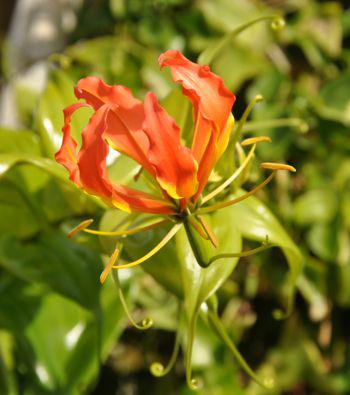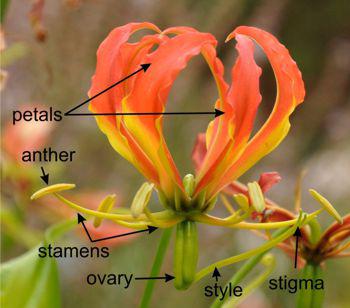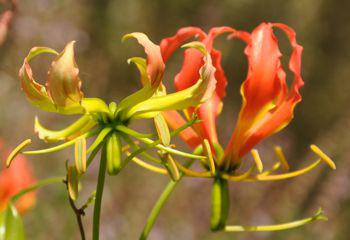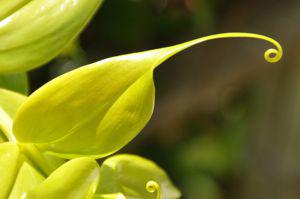Gloriosa superba
Gloriosa superba L.
Family: Colchicaceae
Common names: flame lily, climbing lily, Turk’s cap, superb lily, glory lily, gloriosa lily (Eng.); vlamlelie, boslelie, geelboslelie, rooiboslelie (Afr.); ihlamvu, ihlamvu-labafana, ihlamvu -lomfana nentombazana, ihlamvu lasolwandle, isikwali sasolwandle, isimiselo (isiZulu).
Introduction
Gloriosa superba is a striking climber with unusual and beautiful, red and yellow, flame-like flowers in summer; it is suitable for shade or sun, and is easy to grow.

Description
Description
Gloriosa superba is a deciduous, summer-growing climber up to 1.5 m tall, with tuberous roots. The slender stems are produced annually and are upright to scrambling and can grow up to 4 m long. Tubers sprout in spring, and a tuber sends up 1 to 6 stems. The leaves are shiny, bright green and are tipped in a tendril, which will cling to anything it touches. The stems die back in late summer and the tubers are dormant during winter.
The showy flowers are borne in summer (November to March) and are usually bi-coloured yellow and orange-scarlet, ageing a deeper shade of orange-red to purple. There is also a pure yellow form. The flowers are borne on long pedicels on the upper parts of the stems. They are nodding, i.e. they are presented up-side-down, with the ovary at the base, the stamens in the middle and the petals at the top. There are 6 free petals, and they are bent backwards (reflexed) so that they are pointing upwards. With their wavy, curling margins, and fiery colours, they really do look like flames. The stamens are large and prominent, and are presented in a ring around the flower, like the spokes of a wagon wheel radiating out around the flower, each tipped with a large anther. The base of the flower is made up of the large, shiny, green ovary tipped by the style, which is bent sharply outwards from the point of attachment at the tip of the ovary, and tipped by a stigma with three short arms.

The colours of the petals in the bi-coloured forms, indicate the stage of development of the flower. The flower buds are yellow or greenish yellow. As the flower opens and matures, the yellow and orange-red colours of the petals develop and deepen. The stigma is receptive for 3 days when the petals show the orange-red tips, yellow middle and greenish base. In pollinated flowers the petals lose the greenish colour at the base, and the top half of the petal remains orange-red and the middle to base is yellow. As the flower ages, the petals become entirely orange-red and the shade darkens. Eventually they wither and turn brown. From tight bud to withering flower takes about 2 weeks. The style and stamens also turn brown and shrivel up, while the green ovary at the centre of the flower, enlarges as the seeds develop inside.

The fruit is a large, leathery, 3-valved capsule, taking 6–10 weeks to ripen. It splits to release large, rounded, 4–5 mm in diameter, red seeds, with a thin fleshy outer layer.

Conservation Status
Status
Gloriosa superba is Red Listed as LC (Least Concern). It is widespread and common in its natural range and does not face any significant threats.
In some parts of the world where it was introduced as an ornamental, such as Australia, it has escaped from gardens and naturalised, and is now an invasive weed.
Distribution and habitat
Distribution description
Gloriosa superba occurs in semi-shade or sun in bushveld, coastal dunes, coastal woodlands, forest, thicket, grassland and savanna-forest boundaries, in the Eastern Cape, KwaZulu-Natal, Mpumalanga, Limpopo and North West provinces in South Africa, and in Swaziland, Botswana, Namibia, Angola and Zimbabwe and into tropical Africa, India and southeastern Asia.
Derivation of name and historical aspects
History
The genus name Gloriosa is from the Latin gloriosus meaning ‘glorious’, ‘famous’ or ‘ostentatious’. The species name superba means ‘superb’ or ‘splendid’. This plant was named for its showy ‘glorious superb’ summer flowers.
The genus Gloriosa is a small genus of about 12 species, found in Africa and Asia. It has recently been expanded to include the former genus Littonia. Three species occur in southern Africa: Gloriosa superba, G. modesta (= Littonia modesta), the climbing Christmas bell or geelklokkie in Afrikaans, and G.rigidifolia (= Littonia rigidifolia). Gloriosa superba L. includes G. simplex L. and G. virescens Lindl.
Gloriosa belongs in the crocus family (Colchicaceae). Other members of this family that are well-known to gardeners, include Sandersonia aurantiaca, Christmas bells, and Colchicum species and hybrids, the many kinds of crocus, native to Europe, North Africa and Asia, and grown in many gardens.
Gloriosa superba is the national flower of Zimbabwe.
Ecology
Ecology
Gloriosa superba has weak stems and uses other plants for support, climbing by means of the tendrils at its leaf tips, which cling to shrubs and trees that they touch.

Tubers are eaten by porcupines.
It has not been established what pollinates the flowers, but from the size of the flowers, and the position of the anthers and stigma in relation to the flower and the nectar it produces, it would be expected to be a strong-flying creature with a long beak or tongue, that perches on the flower stalk or hovers beside the flower and comes into contact with an anther and/or the stigma while feeding on the nectar, such as a small, nectar-feeding bird like a sunbird, a butterfly, hawk moth or a long-tongued fly. However, pollination is achieved, the flowers set seed successfully even outside of their natural distribution range.
A study on seed yield in India, found that seed yield in wild plants was low and variable, and that controlled self pollination between flowers on the same plant, gave significantly higher seed yield. Also, that the controlled self pollination produced better results that controlled cross pollination, between flowers on different plants. Looking at any one flower, the stigma becomes receptive 24 to 36 hours after the anthers release their pollen, so that it is unlikely to be pollinated by pollen from the same flower. This study ruled out honey-bees as pollinators as the flowers exposed only to them, produced the least amount of seeds, and established that Gloriosa superba has no genetic self-incompatibility, i.e. fertile seeds are produced from both cross- and self-pollination. It is also noted that the flowers open sequentially so that no two flowers on a branch are at the same stage of development at any time. This adaptation results in low seed yield, but good seed quality.
Uses
Use
PLEASE NOTE: that all parts of this plant, both above and below ground, but particularly the tubers, are extremely poisonous, and ingestion could be fatal. The plants contain the alkaloid colchicine. It is a widely used and effective medicinal plant, but incorrect dosage has caused human deaths. Use with extreme caution and only under guidance of a qualified practitioner. Keep the tubers and the seed capsules away from pets and children and do not let the sap come into contact with your mouth or eyes while working with them, as it can cause skin irritation. The tubers are poisonous to grazing stock.
Gloriosa superba is used in traditional medicine in African and Asian countries and in India, and is farmed for its chemical compounds. It is used to treat a wide range of ailments and diseases in southern Africa, including intestinal worms, haemorrhoids, sprains, strains and bruises, impotence and infertility, as an antispasmodic, and for skin problems, tick infections, to kill lice, disinfect wounds and treat screw worm on cattle. The juice is used to treat snakebite and scorpion stings. Juice of the tuber is also used as a pain killer on a painful tooth. It has also been used as an arrow poison in parts of Africa. In India it is used mainly to treat gout and rheumatism. It is also been identified as a potential anti-cancer drug.
The bright red seeds are used to make decorative necklaces.
Gloriosa superba is a well-known and rewarding ornamental plant, grown in many countries across the world.
Growing Gloriosa superba
Grow
Grow Gloriosa superba in fertile, well-composted soil in a sunny, semi-shaded or lightly shaded position, and water well in spring and summer. They will tolerate poor soils, but perform better in fertile loamy soil. Allow them to scramble up through shrubs and trees or give them a string or thin-wire trellis to climb. They won’t cling to poles or chunky wooden trellises, and while they are mostly tough and easy to grow, the stems can be damaged and growth halted by attempts to train or redirect them. It is a good container plant. In winter-rainfall climates, keep them dry in winter or grow them in well-drained soil, as the dormant tubers are prone to rotting. Gloriosa superba is tender to frost and in cold climates should be planted out once all danger of frost is passed. It is also suitable for coastal gardens, even those that get salt-laden winds as it occurs naturally in coastal dunes in some areas.
Gloriosa superba can be propagated by seed or division of the tubers.
Lift and divide the tubers in late winter while the plants are dormant, but just before new growth starts in spring. Handle the tubers with care as they are delicate and brittle. They are slow to increase by tuber, and should not be lifted more frequently than every three years.
Sow seeds in spring. Germination is best at warm temperatures between 20º and 25ºC, but not higher. Remove the fleshy outer coat and soak the seeds in warm water overnight. Use well-drained, sterile potting soil, press them into the soil and cover lightly. Keep the trays moist but not wet. Germination is erratic, occurring in 2 weeks to 3 months, with some seeds remaining dormant for up to 9 months. Seedlings can be planted out straight into the garden or their container as soon as they are large enough to handle, or pot them up and grow them on in the nursery. Young plants grow rapidly, but a plant takes 3–4 years to flower for the first time from seed.
References
- Contu, S. 2013. Gloriosa superba. The IUCN Red List of Threatened Species. version 2014.3.
. Downloaded on 02 February 2015. - http://Redlist.sanbi.org
- http://www.zim.gov.zw/index.php/national-symbols/national-flower accessed 2 February 2015
- Hutchings, A., Scott, A.H., Lewis, G. & Cunningham, A.B. 1996. Zulu medicinal plants: an inventory. University of Natal Press, Pietermaritzburg.
- Jackson, W.P.U. 1990. Origins and meanings of names of South African plant genera. University of Cape Town.
- Leistner, O.A. (ed.). 2000. Seed plants of southern Africa: families and genera. Strelitzia 10. National Botanical Institute, Pretoria.
- Manning, J. 2001. Eastern Cape. South African Wild Flower Guide 11. Botanical Society of South Africa, Cape Town.
- Maroyi, A. & Van der Maesen, L.J.G. 2011. Gloriosa superba L. (family Colchicaceae): Remedy or poison? Journal of Medicinal Plants Research 5(26): 6112–6121.
- Plants of southern Africa: an online checklist. http:posa.sanbi.org
- Pooley, E. 1998. A field guide to wild flowers Kwazulu-Natal and the eastern region. Natal Flora Publications Trust, Durban.
- Protabase. Dounias, E. Gloriosa superba Protabase Record display http://www.prota4u.org/downloads/Gloriosa+superba/Gloriosa+superba.pdf downloaded 2 February 2015
- Raina, R. & Gupta, L.J. 1999. Increasing seed yield in Glory Lily (Gloriosa superba) — experimental approaches. Acta Hort. 502: 175–179.
- Roberts, M. 1990. Indigenous healing plants. Southern Book Publishers, Halfway House, Johannesburg.
- Selvarasu, A. & Kandhasamy, R. 2012. Reproductive biology of Gloriosa superba. Open Access Journal of Medicinal and Aromatic Plants 3(2): 511.
- Smith, C.A. 1966. Common names of South African plants. Memoirs of the Botanical Survey of South Africa No. 35. Government Printer, Pretoria.
- Van Wyk, B.-E. & Gericke, N. 2000. People's plants . Briza Publications, Pretoria.
- Weeds of Australia. Glory Lily, Gloriosa superba Fact Sheet. Accessed 2 February 2015. http://keyserver.lucidcentral.org/weeds/data/03030800-0b07-490a-8d04-0605030c0f01/media/Html/Gloriosa_superba.htm
Credits
Alice Notten
Kirstenbosch National Botanical Garden
June 2015
Plant Attributes:
Plant Type: Bulb, Climber
SA Distribution: Eastern Cape, KwaZulu-Natal, Limpopo, Mpumalanga
Soil type: Sandy, Loam
Flowering season: Early Summer, Late Summer
PH: Neutral
Flower colour: Red, Yellow, Orange
Aspect: Full Sun, Shade, Morning Sun (Semi Shade), Afternoon Sun (Semi Shade)
Gardening skill: Average
Special Features:
Horticultural zones











Rate this article
Article well written and informative
Rate this plant
Is this an interesting plant?
User Comments
Yvonne Reynolds, South Africa
June 18, 2015 at 4:02 PMThis plant even grows in my garden in Cape Town without any care coming up each year. It seems to like sandy soils and I have seen it growing in the sand dunes at Kei Mouth.
00263782984107 , Zimbabwe
January 25, 2017 at 7:28 AMI wish to buy seeds and tubers
Alice Notten
January 26, 2017 at 8:23 AMSeeds are available from the Kirstenbosch Seedroom.
Download the catalogue and order form from this page: http://www.sanbi.org/gardens/kirstenbosch/kirstenbosch-nbg-seedroom
Login to add your Comment
Back to topNot registered yet? Click here to register.